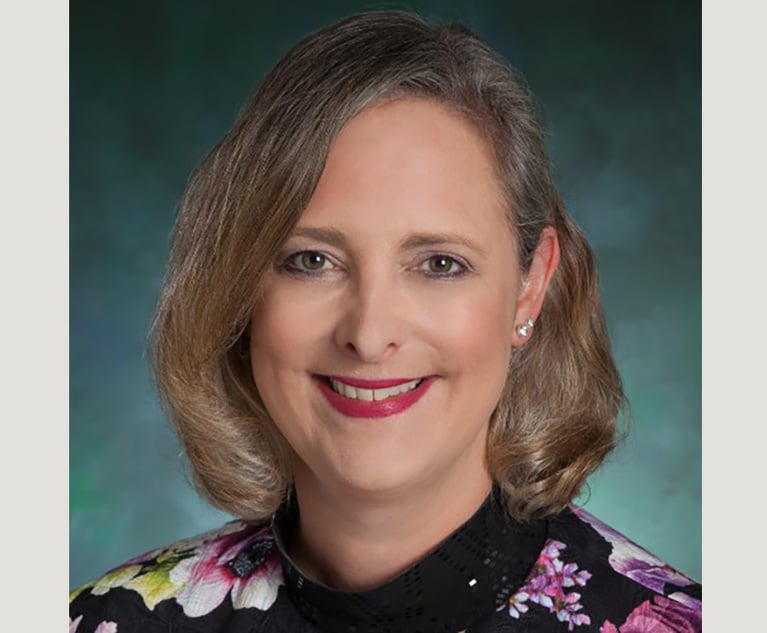Diversity at law firms: Can GCs look beyond the numbers?
If the objective is real diversity, wed suggest that a closer dialogue on actual practices will benefit everyone. Are senior managers and rainmakers visibly and insistently supporting the diversity goal?
September 30, 2014 at 08:00 PM
7 minute read
When it comes to diversity, the spirit of some firms may be strong but the proverbial flesh is weak. They want to recruit and retain more people of color, women, and, presumably LGBT (lesbian, gay, bisexual and transgender) talent, and for many good reasons. By far the most important is that they're acutely aware of how relentlessly their clients insist on it.
Yet at the end of the day, the numbers are flat. For example, around 1 in 8 ethnic minority attorneys made partner in 2012, according to a survey by the Minority Corporate Counsel Association and Vault.com.
Today we hear the same lament as four decades ago: There aren't enough diverse associates in the pipeline, so the partner elevation process is constricted from the get-go. It's a lamentable situation, because it strongly suggests that the biggest problem is retention, and retention problems bespeak cultural issues.
Of course the numbers are important and both OGCs and C-suites have proven in the past that direct pressure can improve percentages. Enhanced results in partner as well as associate demographics are particularly evident among industries that were themselves historically ahead of the game in appointing diverse legal service buyers to top in-house law and other key positions.
No one should suggest that GCs stop pressuring law firms to show quantifiable results. At the same time, in-house counsel can exert broader pressure on firms by looking beyond the numbers. To what extent do the firms they retain or consider retaining have systems in place to enhance recruitment and especially retention? What are the telltale signs that a firm is or isn't doing everything possible to achieve success?
If the objective is real diversity, we'd suggest that a closer dialogue on actual practices will benefit everyone. Are senior managers and rainmakers visibly and insistently supporting the diversity goal? If not, why should you as the client see the program as more than window-dressing? If so, such senior involvement sends a strong reminder to partners to consider diversity when staffing their matters.
Leadership in the ranks. Are there diverse practice group heads, office managing partners and committee leaders? If so, there's a strong likelihood that incoming associates will enjoy the support they deserve. It also suggests that diverse lawyers are very much a part of succession plans.
Diversity officers. Is there a partner assigned to oversee the diversity initiative? Has a diversity professional been hired to focus full-time on the effort? If so, to whom does he/she report?
Diversity incentives. Some firms reward partners for measurable gains on the diversity front. Some firms hold partners accountable, periodically evaluating their individual efforts.
Client teams. What role do diverse attorneys play on the teams handling your work? Are diverse attorneys conspicuously present at beauty contests but conspicuously absent afterward?
Mentoring. Are diverse associates adequately nurtured? Not just assigned mentors; informal relationships are just as important.
LGBT awareness. Is the firm as cognizant of its obligations in this area as with people of color and women? Don't make diversity a zero sum game where resources invested in women and minorities cause LGBT attorneys to feel excluded.
Flex time. What provisions enable lawyers to control their own lives without compromising client service? Is there a stigma attached when lawyers avail themselves of these options?
Business development. Is the firm supporting professional groups that provide diverse lawyers business development opportunities to enhance their shot at partnership?
In the final analysis, it's a carrot-and-stick strategy for in-house lawyers. The carrot is all about the inside/outside partnership and the progress that can be achieved as a result. The stick is all about hiring somebody else if it's not.
When it comes to diversity, the spirit of some firms may be strong but the proverbial flesh is weak. They want to recruit and retain more people of color, women, and, presumably LGBT (lesbian, gay, bisexual and transgender) talent, and for many good reasons. By far the most important is that they're acutely aware of how relentlessly their clients insist on it.
Yet at the end of the day, the numbers are flat. For example, around 1 in 8 ethnic minority attorneys made partner in 2012, according to a survey by the Minority Corporate Counsel Association and Vault.com.
Today we hear the same lament as four decades ago: There aren't enough diverse associates in the pipeline, so the partner elevation process is constricted from the get-go. It's a lamentable situation, because it strongly suggests that the biggest problem is retention, and retention problems bespeak cultural issues.
Of course the numbers are important and both OGCs and C-suites have proven in the past that direct pressure can improve percentages. Enhanced results in partner as well as associate demographics are particularly evident among industries that were themselves historically ahead of the game in appointing diverse legal service buyers to top in-house law and other key positions.
No one should suggest that GCs stop pressuring law firms to show quantifiable results. At the same time, in-house counsel can exert broader pressure on firms by looking beyond the numbers. To what extent do the firms they retain or consider retaining have systems in place to enhance recruitment and especially retention? What are the telltale signs that a firm is or isn't doing everything possible to achieve success?
If the objective is real diversity, we'd suggest that a closer dialogue on actual practices will benefit everyone. Are senior managers and rainmakers visibly and insistently supporting the diversity goal? If not, why should you as the client see the program as more than window-dressing? If so, such senior involvement sends a strong reminder to partners to consider diversity when staffing their matters.
Leadership in the ranks. Are there diverse practice group heads, office managing partners and committee leaders? If so, there's a strong likelihood that incoming associates will enjoy the support they deserve. It also suggests that diverse lawyers are very much a part of succession plans.
Diversity officers. Is there a partner assigned to oversee the diversity initiative? Has a diversity professional been hired to focus full-time on the effort? If so, to whom does he/she report?
Diversity incentives. Some firms reward partners for measurable gains on the diversity front. Some firms hold partners accountable, periodically evaluating their individual efforts.
Client teams. What role do diverse attorneys play on the teams handling your work? Are diverse attorneys conspicuously present at beauty contests but conspicuously absent afterward?
Mentoring. Are diverse associates adequately nurtured? Not just assigned mentors; informal relationships are just as important.
LGBT awareness. Is the firm as cognizant of its obligations in this area as with people of color and women? Don't make diversity a zero sum game where resources invested in women and minorities cause LGBT attorneys to feel excluded.
Flex time. What provisions enable lawyers to control their own lives without compromising client service? Is there a stigma attached when lawyers avail themselves of these options?
Business development. Is the firm supporting professional groups that provide diverse lawyers business development opportunities to enhance their shot at partnership?
In the final analysis, it's a carrot-and-stick strategy for in-house lawyers. The carrot is all about the inside/outside partnership and the progress that can be achieved as a result. The stick is all about hiring somebody else if it's not.
This content has been archived. It is available through our partners, LexisNexis® and Bloomberg Law.
To view this content, please continue to their sites.
Not a Lexis Subscriber?
Subscribe Now
Not a Bloomberg Law Subscriber?
Subscribe Now
NOT FOR REPRINT
© 2025 ALM Global, LLC, All Rights Reserved. Request academic re-use from www.copyright.com. All other uses, submit a request to [email protected]. For more information visit Asset & Logo Licensing.
You Might Like
View All
Global Software Firm Trying to Jump-Start Growth Hands CLO Post to 3-Time Legal Chief

In-House Legal Network The L Suite Acquires Legal E-Learning Platform Luminate+

Antitrust in Trump 2.0: Expect Gap Filling from State Attorneys General
6 minute readTrending Stories
- 1SurePoint Acquires Legal Practice Management Company ZenCase
- 2Day Pitney Announces Partner Elevations
- 3The New Rules of AI: Part 2—Designing and Implementing Governance Programs
- 4Plaintiffs Attorneys Awarded $113K on $1 Judgment in Noise Ordinance Dispute
- 5As Litigation Finance Industry Matures, Links With Insurance Tighten
Who Got The Work
J. Brugh Lower of Gibbons has entered an appearance for industrial equipment supplier Devco Corporation in a pending trademark infringement lawsuit. The suit, accusing the defendant of selling knock-off Graco products, was filed Dec. 18 in New Jersey District Court by Rivkin Radler on behalf of Graco Inc. and Graco Minnesota. The case, assigned to U.S. District Judge Zahid N. Quraishi, is 3:24-cv-11294, Graco Inc. et al v. Devco Corporation.
Who Got The Work
Rebecca Maller-Stein and Kent A. Yalowitz of Arnold & Porter Kaye Scholer have entered their appearances for Hanaco Venture Capital and its executives, Lior Prosor and David Frankel, in a pending securities lawsuit. The action, filed on Dec. 24 in New York Southern District Court by Zell, Aron & Co. on behalf of Goldeneye Advisors, accuses the defendants of negligently and fraudulently managing the plaintiff's $1 million investment. The case, assigned to U.S. District Judge Vernon S. Broderick, is 1:24-cv-09918, Goldeneye Advisors, LLC v. Hanaco Venture Capital, Ltd. et al.
Who Got The Work
Attorneys from A&O Shearman has stepped in as defense counsel for Toronto-Dominion Bank and other defendants in a pending securities class action. The suit, filed Dec. 11 in New York Southern District Court by Bleichmar Fonti & Auld, accuses the defendants of concealing the bank's 'pervasive' deficiencies in regards to its compliance with the Bank Secrecy Act and the quality of its anti-money laundering controls. The case, assigned to U.S. District Judge Arun Subramanian, is 1:24-cv-09445, Gonzalez v. The Toronto-Dominion Bank et al.
Who Got The Work
Crown Castle International, a Pennsylvania company providing shared communications infrastructure, has turned to Luke D. Wolf of Gordon Rees Scully Mansukhani to fend off a pending breach-of-contract lawsuit. The court action, filed Nov. 25 in Michigan Eastern District Court by Hooper Hathaway PC on behalf of The Town Residences LLC, accuses Crown Castle of failing to transfer approximately $30,000 in utility payments from T-Mobile in breach of a roof-top lease and assignment agreement. The case, assigned to U.S. District Judge Susan K. Declercq, is 2:24-cv-13131, The Town Residences LLC v. T-Mobile US, Inc. et al.
Who Got The Work
Wilfred P. Coronato and Daniel M. Schwartz of McCarter & English have stepped in as defense counsel to Electrolux Home Products Inc. in a pending product liability lawsuit. The court action, filed Nov. 26 in New York Eastern District Court by Poulos Lopiccolo PC and Nagel Rice LLP on behalf of David Stern, alleges that the defendant's refrigerators’ drawers and shelving repeatedly break and fall apart within months after purchase. The case, assigned to U.S. District Judge Joan M. Azrack, is 2:24-cv-08204, Stern v. Electrolux Home Products, Inc.
Featured Firms
Law Offices of Gary Martin Hays & Associates, P.C.
(470) 294-1674
Law Offices of Mark E. Salomone
(857) 444-6468
Smith & Hassler
(713) 739-1250







